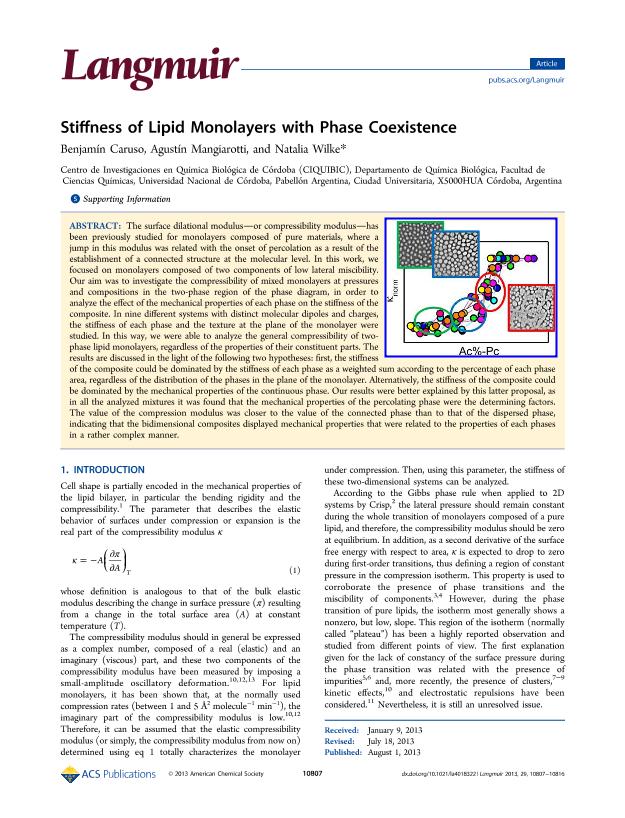Mostrar el registro sencillo del ítem
dc.contributor.author
Caruso, Benjamin

dc.contributor.author
Mangiarotti, Agustín

dc.contributor.author
Wilke, Natalia

dc.date.available
2016-12-28T18:06:48Z
dc.date.issued
2013-08
dc.identifier.citation
Caruso, Benjamin; Mangiarotti, Agustín; Wilke, Natalia; Stiffness of lipid monolayers with phase coexistence; American Chemical Society; Langmuir; 29; 8-2013; 10807-10816
dc.identifier.issn
0743-7463
dc.identifier.uri
http://hdl.handle.net/11336/10516
dc.description.abstract
The surface dilational modulus (or compressibility modulus) has been previously studied for monolayers composed of pure materials, where a jump in this modulus was related with the onset of percolation as a result of the establishment of a connected structure at the molecular level. In this work, we focused on monolayers composed of two components of low lateral miscibility.<br />Our aim was to investigate the compressibility of mixed monolayers at pressures and compositions in the two-phase region of the phase diagram, in order to analyze the effect of the mechanical properties of each phase on the stiffness of the composite. In nine different systems with distinct molecular dipoles and charges, the stiffness of each phase and the texture at the plane of the monolayer were studied. In this way, we were able to analyze the general compressibility of two phase lipid monolayers, regardless of the properties of their constituent parts. The results are discussed in the light of the following two hypotheses: first, the stiffness of the composite could be dominated by the stiffness of each phase as a weighted sum according to the percentage of each phase area, regardless of the distribution of the phases in the plane of the monolayer. Alternatively, the stiffness of the composite could be dominated by the mechanical properties of the continuous phase. Our results were better explained by this latter proposal, as in all the analyzed mixtures it was found that the mechanical properties of the percolating phase were the determining factors. The value of the compression modulus was closer to the value of the connected phase than to that of the dispersed hase, indicating that the bidimensional composites displayed mechanical properties that were related to the properties of each phases in a rather complex manner.
dc.format
application/pdf
dc.language.iso
eng
dc.publisher
American Chemical Society

dc.rights
info:eu-repo/semantics/openAccess
dc.rights.uri
https://creativecommons.org/licenses/by-nc-sa/2.5/ar/
dc.subject
Monolayer Stiffness
dc.subject
Bidimentional Composite
dc.subject
Phase Coexistence
dc.subject
Compressibility
dc.subject.classification
Biofísica

dc.subject.classification
Ciencias Biológicas

dc.subject.classification
CIENCIAS NATURALES Y EXACTAS

dc.title
Stiffness of lipid monolayers with phase coexistence
dc.type
info:eu-repo/semantics/article
dc.type
info:ar-repo/semantics/artículo
dc.type
info:eu-repo/semantics/publishedVersion
dc.date.updated
2016-12-28T17:54:39Z
dc.journal.volume
29
dc.journal.pagination
10807-10816
dc.journal.pais
Estados Unidos

dc.journal.ciudad
Washington
dc.description.fil
Fil: Caruso, Benjamin. Consejo Nacional de Investigaciones Científicas y Técnicas. Centro Científico Tecnológico Córdoba. Centro de Investigaciones en Química Biológica de Córdoba (p); Argentina. Universidad Nacional de Córdoba; Argentina
dc.description.fil
Fil: Mangiarotti, Agustín. Consejo Nacional de Investigaciones Científicas y Técnicas. Centro Científico Tecnológico Córdoba. Centro de Investigaciones en Química Biológica de Córdoba (p); Argentina. Universidad Nacional de Córdoba; Argentina
dc.description.fil
Fil: Wilke, Natalia. Consejo Nacional de Investigaciones Científicas y Técnicas. Centro Científico Tecnológico Córdoba. Centro de Investigaciones en Química Biológica de Córdoba (p); Argentina. Universidad Católica de Córdoba; Argentina
dc.journal.title
Langmuir

dc.relation.alternativeid
info:eu-repo/semantics/altIdentifier/url/http://pubs.acs.org/doi/abs/10.1021/la4018322
dc.relation.alternativeid
info:eu-repo/semantics/altIdentifier/url/http://dx.doi.org/10.1021/la4018322
Archivos asociados
